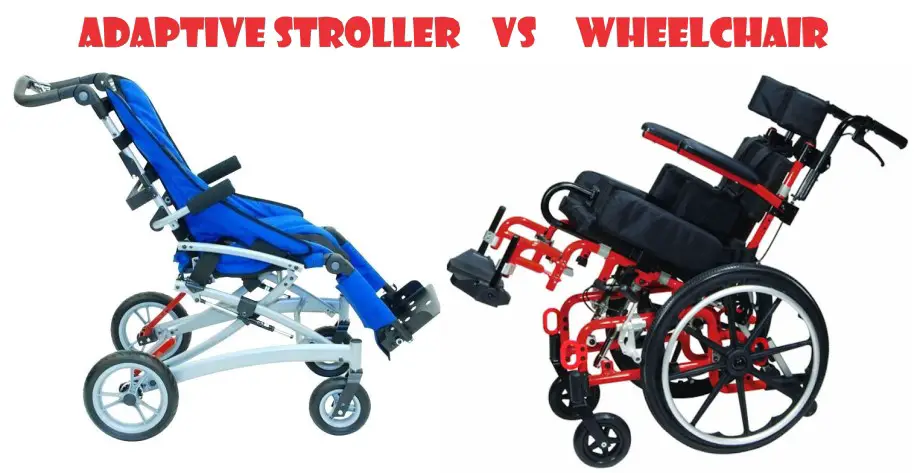Choosing between an adaptive stroller and a wheelchair can be tough when purchasing a mobility aid for your child.
It’s probably your first time taking care of a disabled child, and the best experience you’ve got on mobility aids is seeing people frequently use a particular type.
There are various factors to watch out for when buying a mobility aid. The need and environment of the user influence these factors.
Picking the right choice between an adaptive stroller and a wheelchair will become easy after you compare the two properly.
Table of Contents
- Advantages of Buying an Adaptive Stroller
- The Downsides of Buying an Adaptive Stroller
- Advantages of Buying a Wheelchair
- The Downsides of Buying a Wheelchair
- The Right Choice to Make
- Tips to Help You Get the Right Adaptive Stroller or Wheelchair
Advantages of Buying an Adaptive Stroller
Adaptive strollers are usually three-wheel or four-wheel mobility aids used to assist special-needs children to move about. They come in various types and sizes to accommodate the weight of different age grades of children.
They could be designed to fit on car seats, fit in buses, or made to move on rough terrains. Some advantages of adaptive strollers are listed below.

1) Lightweight
Adaptive strollers are lightweight mobility aid. This lightweight allows you to easily carry it about. If you transport your child via public transit regularly, or you love your child to join you in outdoor activities like shopping, then an adaptive stroller will give your child the comfort they need.
Related: Lightweight vs. Standard Wheelchair: Here’s the Right One to Choose
2) Flexibility for Comfort
Buying an adaptive stroller for your child gives them the option of staying at various comfortable positions while you push them. It will come in handy if your child undergoes surgery or treatments and your doctor advises they remain in a particular position always.
You can recline an adaptive stroller’s seat and adjust its arms to make your child comfortable. Some adaptive strollers allow you to rotate their seats in the opposite direction, permitting easy communication with your child when pushing them.
3) Small Size
If you’re concerned about the bulkiness of your child’s mobility aid, then you should consider purchasing an adaptive stroller. The small size of an adaptive stroller also allows you to easily pass through narrow aisles, hallways, and doorways. Your child will also appreciate its small size because it enables them to sit firmly without gliding sideways.
4) Beautiful Aesthetics
Adaptive strollers usually come in varieties of colors, fancy straps, and an extra basket underneath them. These features excite children and might just be what you need to encourage your child to go out with you. Some products allow you to change the seats and install another one on the same frame.
Related: Group 2 vs. Group 3 Power Wheelchair: Here’s the Right One to Choose
The Downsides of Buying an Adaptive Stroller
A common disadvantage of buying an adaptive stroller is the need to always get a bigger size as your child grows. Growth in children may sometimes be rapid. Changing adaptive strollers as your child grows older will definitely put a strain on your finance.
If your child isn’t using the adaptive stroller frequently, consider renting one to save cost. Better still, buy a used adaptive stroller and resell them when your child has outgrown it.
Advantages of Buying a Wheelchair

Just like adaptive strollers, wheelchairs will support your child who may have a disability or an injury affecting their mobility.
Wheelchairs have four wheels and maybe manual or have power drive systems the user can use in controlling the wheelchair. Your child’s needs will determine the type you will get for them. Some advantages of wheelchairs include the following.
1) Availability of Power System Drives
Unlike adaptive strollers, some wheelchairs are motorized. The motor system will allow your child to control the movement of the wheelchair with the help of a hand-held controller or through some eye or head movements.
This power system drive gives your child some level of independence as they can travel long distances without being pushed. Also, your child won’t have to get weary from constantly rolling the wheels manually.
2) Availability of Smart Features
Wheelchairs have continued to undergo technological advancement. Some smart features include power elevating seats which can elevate the user to a higher height and standing power wheelchairs which can take a user from a sitting position to a standing position and vice versa. You may not find these features in adaptive wheelchairs.
3) Accommodative Size
Wheelchairs can accommodate various body sizes. Your child will be able to use a wheelchair while transitioning from childhood to adolescence and even up to adulthood. You won’t have to worry much about the wheelchair not being able to accommodate your child’s body size or weight.
Related: Hemi Height Wheelchair vs. Standard Wheelchair
The Downsides of Buying a Wheelchair
Most wheelchairs, especially powered wheelchairs, are heavier than adaptive strollers. Transporting them from place to place is more stressful, limiting the places your child can visit. Also, you can’t easily use them in areas with narrow paths.
The Right Choice to Make
From the comparison above, you should consider buying an adaptive stroller for your child if they are still an infant. Postpone the idea of introducing a wheelchair to your child until they are about 7 – 10 years old. When buying a wheelchair for your child, go for a pediatric wheelchair. As your child gets older, you can switch to bigger wheelchairs.
Tips to Help You Get the Right Adaptive Stroller or Wheelchair
After deciding on the kind of mobility aid to purchase, you must ensure you get the right quality, brand, and model. Below are some tips to guide you.
1) Choose a Light Adaptive Stroller or Wheelchair
Buying a lightweight, adaptive stroller or wheelchair allows you to go outdoors with them easily. If you’re buying a wheelchair, buy a foldable one. Only go for the rigid type if you always have to carry them from place to place.
2) Consider the Health of Your Child
If your child can operate a powered wheelchair, consider buying one for them. Wheeling a manual wheelchair over a long distance will cause your child to wear out easily.
3) Look Out for Adjustable Features
Some adaptive strollers and wheelchairs come with adjustable backrests, wheels, heights, and armrests. These adjustable features will maximize your child’s comfort when wheeling them. Make sure to buy an adaptive stroller or wheelchair with these features.




